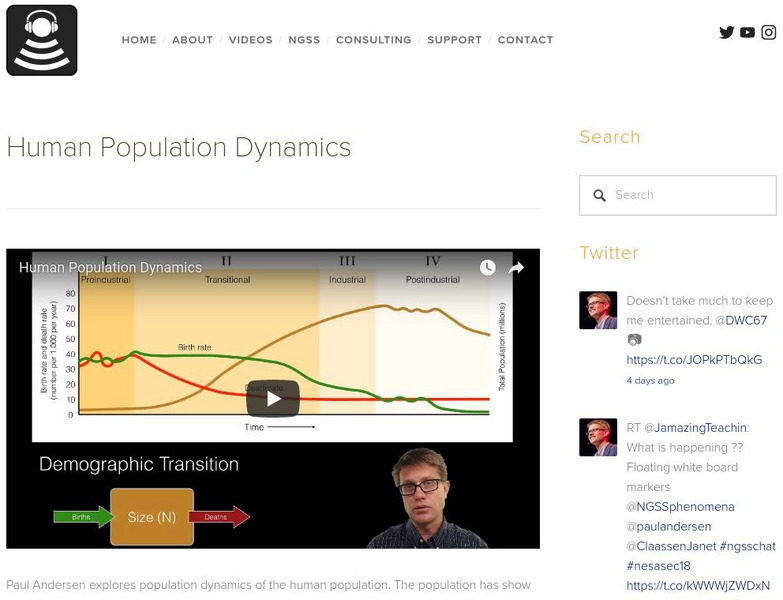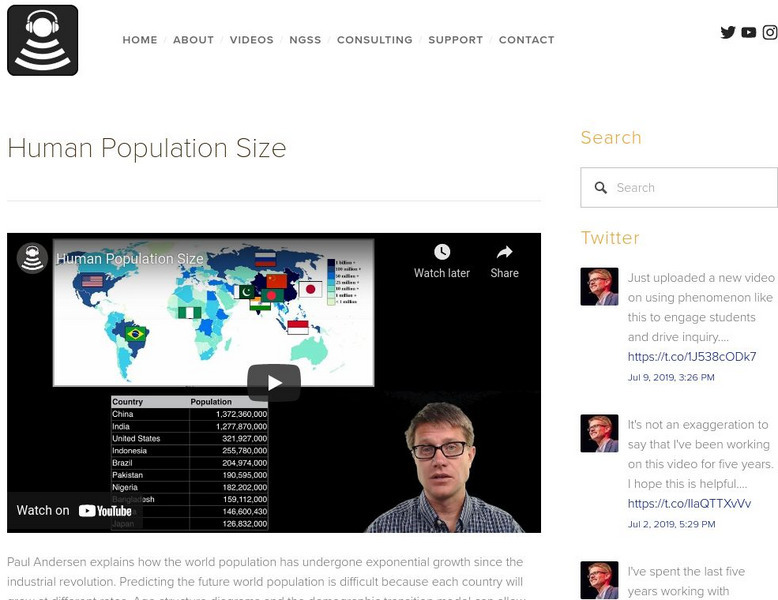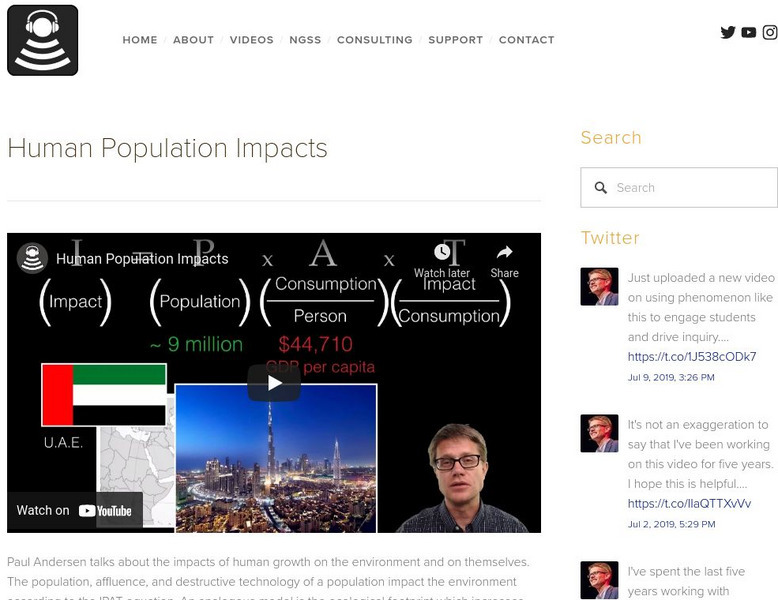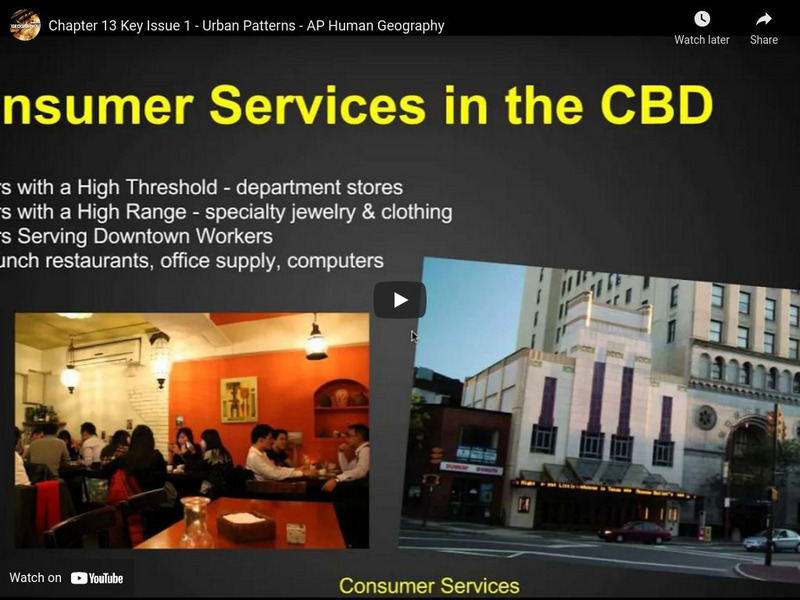Global Health with Greg Martin
Pandemics - a worrying global public health threat
Pandemics are one of the greatest existential threats facing humanity today. Over the last few centuries, we've seen outbreaks and epidemics kill millions of people. From plague in the 14th century to influenza in the 20th century,...
NASA
Using Precipitation Data to Assess Risk of Cholera Outbreaks
A new modeling approach using satellite data will likely to enhance our ability to develop cholera risk maps in several regions of the globe. The model (GCRM) is based on monthly air temperature, precipitation, availability of WASH...
FuseSchool
BIOLOGY - Environment - Human impact
In this video we'll learn about how human activity has a negative impact on the Earth because of burning fossil fuels, deforestation and creating waste.
Professor Dave Explains
Routes of Viral Transmission
Now we know a bit more about how viruses interact with cells, whether those are bacterial cells, or animal cells, such as ours. But how do they gain access to our cells in the first place? How do viruses get inside the human body? Let's...
Nature League
Increasing Night Life of Mammals - De-Natured
In this De-Natured segment of Nature League, Brit breaks down a recent scientific journal article about the increasing nocturnality of mammals around the globe. Article citation: Gaynor, K.M., Hojnowski, C.E., Carter, N.H., and...
Curated Video
Culture v2
An introduction to Material Culture, Nonmaterial Culture, Culture lag, Sociobiology.
Bloomberg
Virus Containment Efforts Are Buying Time, Johns Hopkins' Pekosz Says
Feb.25 -- Andrew Pekosz, co-director of the Johns Hopkins Center of Excellence in Influenza Research and Surveillance (JH-CEIRS) and director of the Center for Emerging Viruses and Infectious Diseases (CEVID) at the Bloomberg School of...
Bloomberg
Nobel Laureate Doherty on Coronavirus, Lockdowns, Vaccines
May.03 -- Peter Doherty, a researcher who won a Nobel Prize in Physiology or Medicine in 1996 for discovering how the immune system recognizes virus-infected cells, talks about the covid-19. The patron and namesake of the Peter Doherty...
AFP News Agency
CLEAN : Ebola virus squeezed into much smaller area in DRC: WHO
Ebola virus has been squeezed into a much smaller geographic area in Democratic Republic of Congo but containing a virus is a different prospect to eliminating that virus according to Michael Ryan Executive director of the WHO emergency...
Crash Course
The Anthropocene and the Near Future: Crash Course Big History #9
The Anthropocene covers the last century in an unofficial geological era. An informative video considers both the pros and cons of progress. It discusses the environmental impact, changes in lifestyle, political changes, wars, and...
SciShow
The Science of Overpopulation
The population of the US increased 300 percent in the 20th century, but the use of raw materials increased by 1,700 percent. Explore human population growth over time with a video that examines the history of why such growth has occurred...
Be Smart
Defusing the Population Bomb
With a human population of 7.6 billion and counting, how do we tackle the population problem? Examine the data using a video from an extensive science playlist. The resource explains why the human population began to increase rapidly,...
PBS
Growing Appetites, Limited Resources
Did you know that, as the world's population increases, its demand for energy increases at an even faster rate? Learners watch a short video about the world's energy crisis before discussing the sustainable alternative energy sources....
American Chemical Society
The Future of Fake Meat
Fake nails are one thing ... but fake meat? Agricultural scholars explain how they can fake steak in an engaging video from the American Chemical Society's Reactions playlist. The narrator sets the stage by discussing the amount of...
Bozeman Science
ETS2B - Influence of Science, Engineering and Technology on Society and the Natural World
Science, engineering, and technology have an impact on our natural world. As the world population increases, the demands on natural resources also increase. Science, technology, and engineering work together to address these concerns...
Crash Course
Population, Sustainability, and Malthus: Crash Course World History 215
Thomas Malthus posed the most famous, and most easily disproven, theory about projected population growth in economic history. What did he get wrong—and why? Explore the Malthusian Theory of Population with a Crash Course video that...
Macat
An Introduction to Thomas Malthus' An Essay on the Principle of Population
Can human population ever exceed its ability to produce food? High schoolers watch a short overview of Thomas Malthus's An Essay on the Principle of Population to learn more about the subsistence level of the human population,...
Crash Course
Human Population Growth
The total world population is predicted to pass 8 billion by 2025, which is less than 10 years from now. The video focuses on human population growth and the impact it has had and is having on our planet and other populations. It...
PBS
Nova: World in the Balance: Human Population and Global Trends
A companion site to Nova's film that examines "human populations and environments." Find some fascinating facts in the interactive slide shows "Human Numbers Through Time," and "Global Trends Quiz."
Bozeman Science
Bozeman Science: Human Population Dynamics
Paul Andersen explores population dynamics of the human population. The population has show exponential growth since the industrial revolution and all countries will eventually move through the demographic transition. [11:14]
Bozeman Science
Bozeman Science: Human Population Size
Paul Andersen explains how the world population has undergone exponential growth since the industrial revolution. Predicting the future world population is difficult because each country will grow at different rates. Age-structure...
Bozeman Science
Bozeman Science: Human Population Impacts
Paul Andersen talks about the impacts of human growth on the environment and on themselves. The population, affluence, and destructive technology of a population impact the environment according to the IPAT equation. An analogous model...
Khan Academy
Khan Academy: Human Prehistory 101 Part 2: Weathering the Storm
Third in a series of videos that introduces human prehistory, this video describes how early humans continued to defy the odds and populated the Americas during the last ice age. [3:24]
Other
Mr. Mac Alpine: Patterns of Human Geography, Part 1
Mr. MacAlpine explains the patterns of human settlement and population distribution in Canada and the world, as well as some of the factors that contribute to population density. [15:48]















